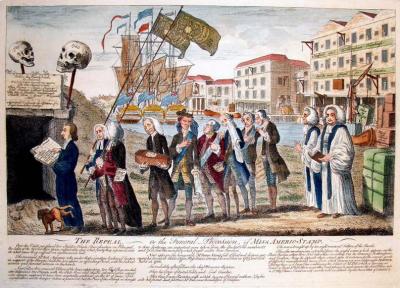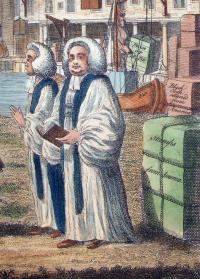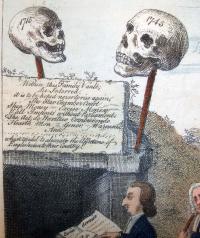After Benjamin Wilson (1721-1788), The Repeal, or the Funeral of Miss Americ-Stamp, 1766. BM 4140 copy B. Engraving with etching and contemporary hand coloring. Graphic Arts GA 2010. in process.
The Stamp Act of 1765 generated intense opposition with the American colonists, who called for a boycott of British imports. Needing the revenue from American trade, the British Parliament voted to repeal the Stamp Act in 1766.
The Marques of Rockingham, only recently named Prime Minister, had the difficult job of convincing Parliament of the benefits of this repeal. To help sway public opinion, he commissioned the artist Benjamin Wilson (1721-1788) to draw two satirical prints. The first, published in February 1766, was titled The Tombstone and showed leading “hard liners” dancing on the tomb of the Duke of Cumberland. The second, seen here, was published on March 18, the day Parliament voted the repeal.
The main focus of the print is a funeral procession of Stamp Act supporters carrying a child’s coffin (the Act was only four months old). At the lead is William Scott or Anti-Sejanus, who reads from a sermon. Scott is followed by Solicitor-General Wedderburn and Attorney General Fletcher Norton, carrying flags that display the vote against the repeal; then George Grenville, Lord Bute, Lord Temple, Lord Halifax, and Lord Sandwich. They walk along a harbor that represents the Rockingham ministry with three ships labeled “Conway,” “Rockingham,” and “Grafton.”
Benjamin Franklin was a friend of Wilson and when he received a copy of the print, Franklin wrote, “I think he was wrong to put in Lord Bute, who had nothing to do with the Stamp Act. But it is the Fashion to abuse that Nobleman, as the Author of all Mischief.”
The Repeal quickly became “the most popular satirical print ever issued” according to R.T. Haines Halsey, “Impolitical Prints,” Bulletin of the New York Public Library 43, no.11 (Nov. 1939). Within three days the publisher issued an advertisement requesting patience because he could not keep up with all the orders he had received. Within the week other print sellers were issuing their own versions of Wilson’s scene.
According to the Dictionary of National Biography’s entry on Wilson, the print was titled “The Repeal; or, the Funeral of Miss Ame-Stamp. It was sold for one shilling and brought Wilson 100 pounds in four days. On the fifth day it was pirated, and two inferior versions produced at six-pence.” The British Museum’s catalogue identifies the original etching and six variant editions, A-F.
Graphic Arts recently acquired an excellent impression of copy B, a reduced, chiefly engraved version of Wilson’s print. Processional figures are reproduced on the same scale as the original but the background buildings and ships are altered to fit on a smaller sheet. A descriptive text, once sold separately, is here engraved below the image along with a slightly altered title, now “Americ-Stamp”.
See a copy of [An act for granting and applying certain stamp duties] (London: Printed by Mark Baskett, 1765). Rare Books, William H. Scheide Library (WHS) 16.5.9
E.P. Richardson, “Stamp Act Cartoons in the Colonies,” The Pennsylvania Magazine of History and Biography 96, no. 3 (July 1972).
Here are the complete texts (spelling is transcribed as engraved):
[Above the vault] Within this Family Vault, Lie Interred, it is to be hoped never to rise again, The Star Chamber Court Ship Money Excise Money & all Imposts without Parliament. The Act de Haeritico Comburendo Hearth Mon Gener Warrants And which tended to alienate the Affections of Englishmen to their Country.
[The text below the print] The Repeal. Or the Funeral Procession, of Miss Americ-Stamp. Over the Vault are placed two Skeleton Heads. Their elevation on Poles, and the dates of the two Rebellion Years, sufficiently shew what Party they espoused, and in what cause they suffered an ignominious Exit.
The reverend Mr.Anti-Sejanus (who under that signature hackney’d his pen in support of the Stamps) leads the procession as officiating Priest, with the burial service and funeral sermon in his hands.
Next follow two eminent Pillars of the Law, supporting two black flags, on which are delineated the Stamps with the White Rose and Thistle interwoved, an expressive design, supposed to have been originally contrived on the 10 of June. The significative motto Semper Eadem is preserved, but the Price of the Stamp is changed to three farthings, an important sum taken from the Budget. The numbers 122 and 71 declare the minority which fought under these Banners.
Next appears the honourable Mr. George Stamp, full of Grief and dispair, carrying his favourite Childs Coffin, Miss Americ Stamp, who was born in 1763 and died hard in 1766.
Immediately after, follows the chief Mourner Sejanus.
Then his Grace of Spital Fields, and Lord Gawkee.
After these Jemmy Twitcher, with a Catch, by way of funeral anthem, & by his side his friend and partner Mr. Falconer Donaldson of Halifax.
The rear is brought up by two right reverend Fathers of the Church.
These few mourners are seperated from the joyful scene which appears on the River Thames, where three first rate ships are riding. VIZ. the Conway, Rockingham, and Grafton. Along the opposite Shore, stand open Warehouses, for the several goods of different manufactoring towns from which Cargoes are now shipping for America. Among these is a large Case containing the Statue of Mr. Pitt, which is heaving on board a Boat No. 250, there is another boat taking in goods nearer the first Rates, which is No. 105. These Numbers will ever be held in esteem by the true SONS of LIBERTY.



